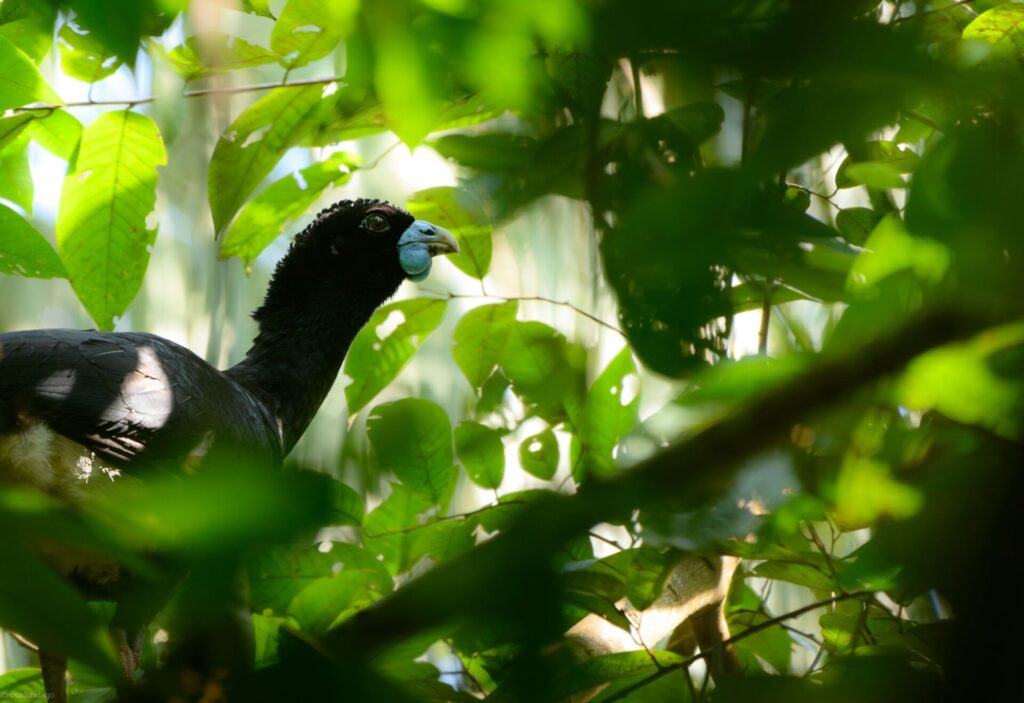When we were researching species to highlight for this year’s World Land Trust (WLT) autumn appeal, one name kept coming up: the Blue-billed Curassow (Crax alberti). And the more we heard, the more intrigued we became.
“I clearly remember the first time I saw a Blue-billed Curassow, the paujil de pico azul,” says Santaigo Rosado, FBC’s Reserve Coordinator. “It was like seeing a ghost! As an ornithologist, finding this bird in its natural habitat, after years of study, was truly amazing.” He pauses, eyes shining. “That moment stays with me.”
Many others spoke with the same sense of awe. Dr. Óscar Laverde from Universidad Javeriana in Bogotá recalls “The first time I heard the curassow, its call resonated through my body and I actually began to feel dizzy. Its song has such low frequency waves. In an instant, I knew what it was.”
A concert in the forest: Julio wakes up early to admire the extraordinary courtship songs of the Blue-billed Curassow. Credit: FBC
It was also the song that caught the attention of Julio Marín-Cruz, FBC’s Regional Environmental Leader. “There are so many sounds in the forest – of cats, reptiles, and birds. But one of the most beautiful is from the Blue-billed Curassow. Many mornings, I get up early to go and listen, and it’s like hearing a wonderful concert”.
With our curiosity thoroughly piqued, we just had to learn more. So we reached out to Paula Caycedo – an ornithologist and FBC’s Coordinator of Fund Management, Communities, and Communications.
“It was the Blue-billed Curassow who called us – and for whom we work – to ensure its survival and wellbeing in perpetuity” Paula Caycedo, FBC’s Coordinator of Fund Management, Communities, and Communications.
Paula Caycedo is an ornithologist who has extensively studied the calls and songs of the enigmatic Blue-billed Curassow.
WLT: What makes the Blue-billed Curassow so special?
Paula: First off, it’s only found in Colombia and is Critically Endangered with perhaps only 150-750 individuals left in the wild. Today, it survives in just two fragmented populations – one in the north and the other in the Middle Magdalena Valley.
In 2005, our colleagues discovered a wonderful refuge for the curassow in this valley – the Barbacoas wetlands. We visited that same year, and there we found our mission: to defend the last remnants of forest and wetlands in the Magdalena River basin. It was the Blue-billed Curassow who called us – and for whom we work – to ensure its survival and wellbeing in perpetuity.
With only 150 to 750 individuals left in the wild, the Blue-billed Curassow is of critical conservation importance, not only within Colombia but globally. Credit: Susanne Cohen
WLT: What fascinating or lesser-known facts about the curassow might surprise people?
Paula: The male curassow sings, or “booms,” from December to mid-April, when the rains begin. Although I haven’t yet been lucky enough to see one in the wild, I’ve spent hours listening to and analysing their courtship songs.
The courtship song consists of extremely low-pitched “booms”. These deep, booming calls are physically impossible for most smaller birds to make and are generated using an inflatable air sac – a feature that curassows use to produce some of the lowest bird vocalisations in the world.
Listening intently: Paula has spent hours in the field recording birdsong and then carefully analysing its component parts.
While songbirds sing at a range of 1,000 to 8,000 Hertz (Hz), the curassow is right down at 75 to 105 Hz, similar to howler monkeys, deer, or even the human voice. If any other bird gave such a low reading, it would be tempting to re-check the spectrogram!
In total, its song consists of three phrases, each made up of 9 to 11 notes. We were even able to distinguish among the songs of three different individuals – showing that each male curassow has their own unique vocal signature.
FBC play an active role in environmental education to encourage the next generation of environmental leaders. Paula describes how she hopes the curassow will become a symbol of belonging for neighbouring communities and live on in the memories of local children and as a friend in their drawings and songs. Credit: FBC
WLT: Can you describe the work FBC is doing to protect this species?
Paula: Although never a common species, the curassow has suffered steep declines from hunting and deforestation. Since 2017, we’ve monitored it across 31 forest fragments in El Silencio Reserve, learning that the bird needs large, connected habitats to survive. These findings are guiding our creation of ecological corridors between remaining forest patches.
Together with local residents, we’re also restoring 12 native fruit trees that provide essential food for the curassow and countless other forest species.
WLT’s autumn appeal will also bring two vital properties – El Taladro and El Jardín – into protection, further expanding habitat for this beautiful bird.
Your support for this appeal will help protect some of the last remaining forest fragments within the Middle Magdalena Valley and provide vital habitat for the Blue-billed Curassow. Credit: FBC
A future of hope
Our conversation with Paula revealed the strong connection between people and wildlife within the Middle Magdalena Valley.
Thanks to the commitment of FBC, the Blue-billed Curassow is steadily making a comeback. This was highlighted by Noel Torres, one of El Silencio Reserve’s rangers. “In my day-to-day work, the hardest animal to see is the elusive Blue-billed Curassow.”
Noel smiles as he scrolls through photos on his phone. “Over the years, we have started seeing them more regularly. These are two males I often see in an area of El Silencio called Alto de Los Paujiles. I’ve been hearing their courtship calls deeper in the forest – and recently, they’ve been coming closer and closer to FBC’s headquarters!”
“It’s amazing to know the difference we are making here.”
Act now to support our autumn appeal and be part of this change.

